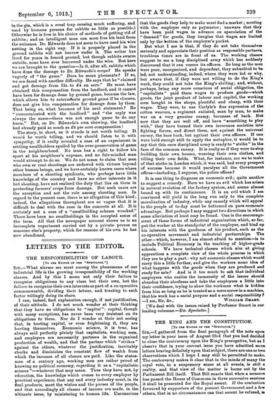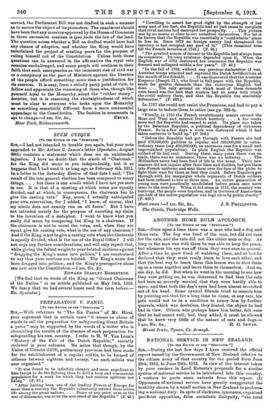THE KING AND THE CONSTITUTION.
[To THE EDITOR or THE "SPECTATOR."]
gathered from the final paragraph of the note upon my letter in your issue of August 23rd that you had decided to close the controversy upon the King's prerogative, but as I observe that in your current issue you have admitted more letters bearing definitely upon that subject, there are one or two observations which I hope I may still be permitted to make. The controversy makes it clear that in the minds of many the royal veto, in a suspensory sense at all events, is still a reality, and that view of the matter is borne out by the Parliament Bill itself. That Bill enacts that when a measure has passed the House of Commons in three successive sessions it shall be presented for the Royal assent. If the contention favoured by supporters of the present Government and a few others, that in no circumstances can that assent be refused, is
correct, the Parliament Bill was not drafted in such a manner as to secure the object of its promoters. The enactment should have been that any measure approved by the House of Commons in three successive sessions is ipso facto the law of the land. The question arises whether a Bill so drafted would have had any chance of adoption, and whether the King would have entertained the project of creating peers for the purpose of ruling himself out of the Constitution. Unless both those questions can be answered in the affirmative the royal veto remains unchallenged, and many people will continue in their faith that such emergencies as the imminent risk of civil war or a conspiracy on the part of Ministers against the liberties of the people afford something more than a justification for ita exercise. It is easy, from a strictly party point of view, to follow and appreciate the reasoning of those who, though like yourself loyal to the Monarchy, adopt the "rubber stamp" doctrine, but it is reasoning the shortsightedness of which must be clear to everyone who looks upon the Monarchy as something essentially different from a mere ornamental appendage to the Constitution. The fashion in ornaments is







































 Previous page
Previous page